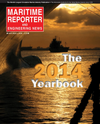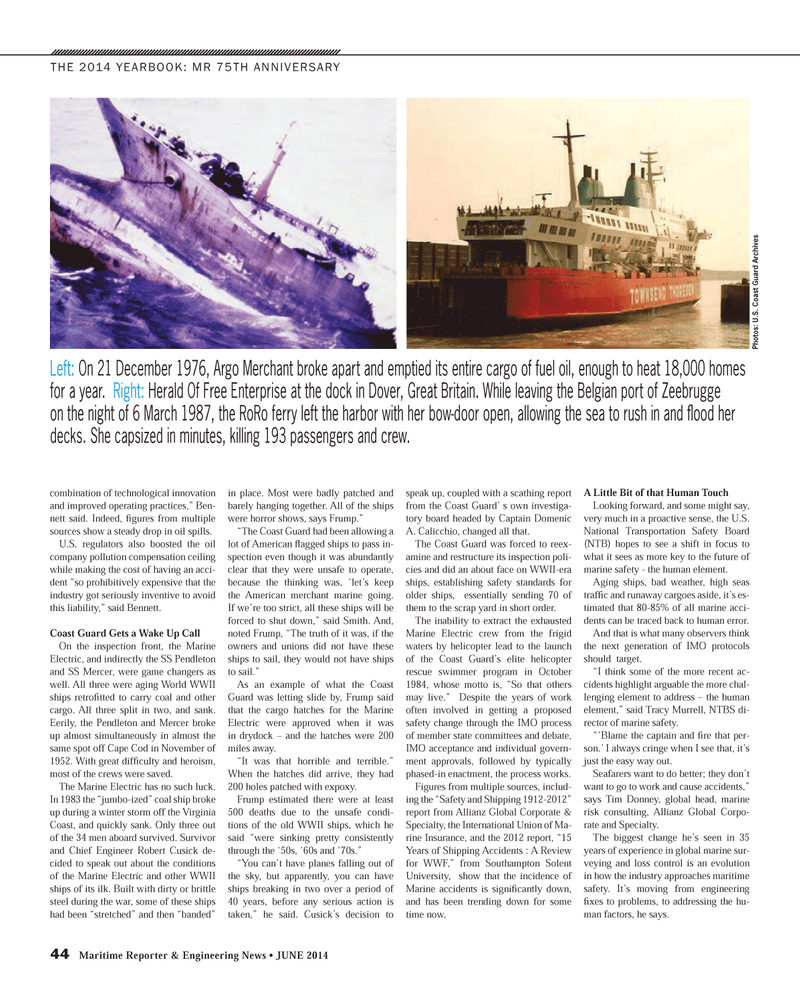
Page 44: of Maritime Reporter Magazine (June 2014)
Annual World Yearbook
Read this page in Pdf, Flash or Html5 edition of June 2014 Maritime Reporter Magazine
44 Maritime Reporter & Engineering News • JUNE 2014 combination of technological innovation and improved operating practices,” Ben- nett said. Indeed, ? gures from multiple sources show a steady drop in oil spills.
U.S. regulators also boosted the oil company pollution compensation ceiling while making the cost of having an acci- dent “so prohibitively expensive that the industry got seriously inventive to avoid this liability,” said Bennett.
Coast Guard Gets a Wake Up Call
On the inspection front, the Marine
Electric, and indirectly the SS Pendleton and SS Mercer, were game changers as well. All three were aging World WWII ships retro? tted to carry coal and other cargo. All three split in two, and sank.
Eerily, the Pendleton and Mercer broke up almost simultaneously in almost the same spot off Cape Cod in November of 1952. With great dif? culty and heroism, most of the crews were saved.
The Marine Electric has no such luck.
In 1983 the “jumbo-ized” coal ship broke up during a winter storm off the Virginia
Coast, and quickly sank. Only three out of the 34 men aboard survived. Survivor and Chief Engineer Robert Cusick de- cided to speak out about the conditions of the Marine Electric and other WWII ships of its ilk. Built with dirty or brittle steel during the war, some of these ships had been “stretched” and then “banded” in place. Most were badly patched and barely hanging together. All of the ships were horror shows, says Frump.” “The Coast Guard had been allowing a lot of American ? agged ships to pass in- spection even though it was abundantly clear that they were unsafe to operate, because the thinking was, ‘let’s keep the American merchant marine going.
If we’re too strict, all these ships will be forced to shut down,” said Smith. And, noted Frump, “The truth of it was, if the owners and unions did not have these ships to sail, they would not have ships to sail.”
As an example of what the Coast
Guard was letting slide by, Frump said that the cargo hatches for the Marine
Electric were approved when it was in drydock – and the hatches were 200 miles away. “It was that horrible and terrible.”
When the hatches did arrive, they had 200 holes patched with expoxy.
Frump estimated there were at least 500 deaths due to the unsafe condi- tions of the old WWII ships, which he said “were sinking pretty consistently through the ‘50s, ‘60s and ‘70s.” “You can’t have planes falling out of the sky, but apparently, you can have ships breaking in two over a period of 40 years, before any serious action is taken,” he said. Cusick’s decision to speak up, coupled with a scathing report from the Coast Guard’ s own investiga- tory board headed by Captain Domenic
A. Calicchio, changed all that.
The Coast Guard was forced to reex- amine and restructure its inspection poli- cies and did an about face on WWII-era ships, establishing safety standards for older ships, essentially sending 70 of them to the scrap yard in short order.
The inability to extract the exhausted
Marine Electric crew from the frigid waters by helicopter lead to the launch of the Coast Guard’s elite helicopter rescue swimmer program in October 1984, whose motto is, “So that others may live.” Despite the years of work often involved in getting a proposed safety change through the IMO process of member state committees and debate,
IMO acceptance and individual govern- ment approvals, followed by typically phased-in enactment, the process works.
Figures from multiple sources, includ- ing the “Safety and Shipping 1912-2012” report from Allianz Global Corporate &
Specialty, the International Union of Ma- rine Insurance, and the 2012 report, “15
Years of Shipping Accidents : A Review for WWF,” from Southampton Solent
University, show that the incidence of
Marine accidents is signi? cantly down, and has been trending down for some time now.
A Little Bit of that Human Touch
Looking forward, and some might say, very much in a proactive sense, the U.S.
National Transportation Safety Board (NTB) hopes to see a shift in focus to what it sees as more key to the future of marine safety - the human element.
Aging ships, bad weather, high seas traf? c and runaway cargoes aside, it’s es- timated that 80-85% of all marine acci- dents can be traced back to human error.
And that is what many observers think the next generation of IMO protocols should target. “I think some of the more recent ac- cidents highlight arguable the more chal- lenging element to address – the human element,” said Tracy Murrell, NTBS di- rector of marine safety. “‘Blame the captain and ? re that per- son.’ I always cringe when I see that, it’s just the easy way out.
Seafarers want to do better; they don’t want to go to work and cause accidents,” says Tim Donney, global head, marine risk consulting, Allianz Global Corpo- rate and Specialty.
The biggest change he’s seen in 35 years of experience in global marine sur- veying and loss control is an evolution in how the industry approaches maritime safety. It’s moving from engineering ? xes to problems, to addressing the hu- man factors, he says.
THE 2014 YEARBOOK: MR 75TH ANNIVERSARY
Left: On 21 December 1976, Argo Merchant broke apart and emptied its entire cargo of fuel oil, enough to heat 18,000 homes for a year. Right: Herald Of Free Enterprise at the dock in Dover, Great Britain. While leaving the Belgian port of Zeebrugge on the night of 6 March 1987, the RoRo ferry left the harbor with her bow-door open, allowing the sea to rush in and fl ood her decks. She capsized in minutes, killing 193 passengers and crew.
Photos: U.S. Coast Guar d Ar chives
MR #6 (40-49).indd 44 6/9/2014 11:15:07 AM

 43
43

 45
45
